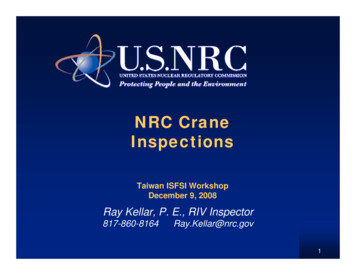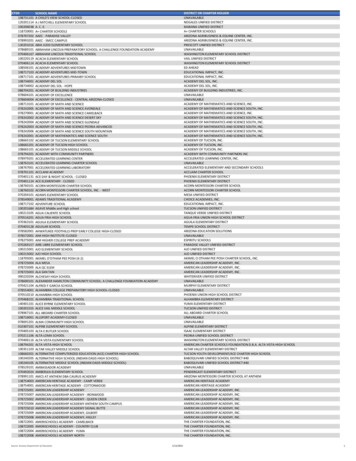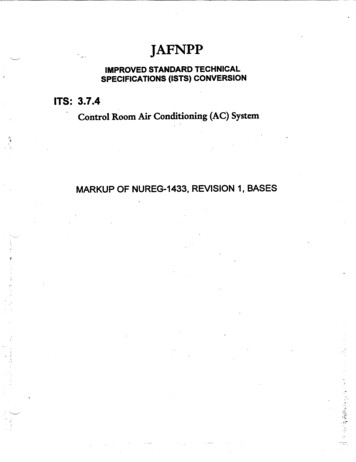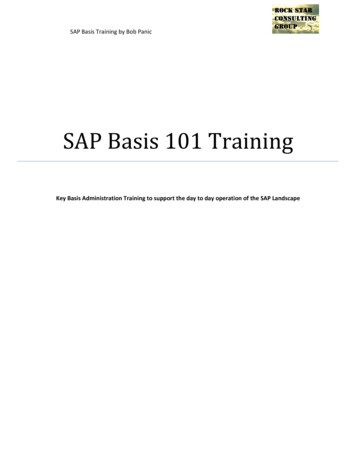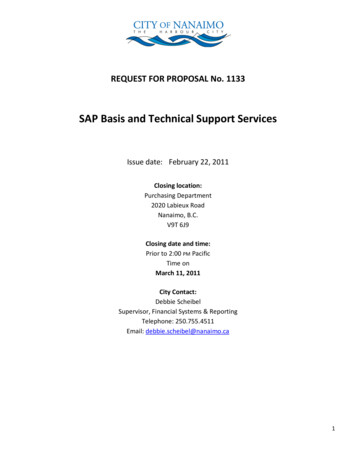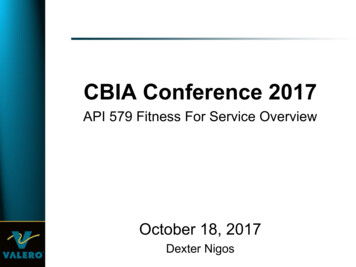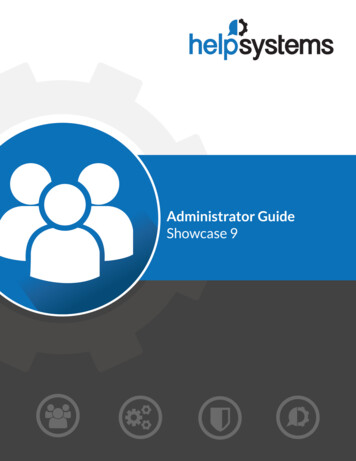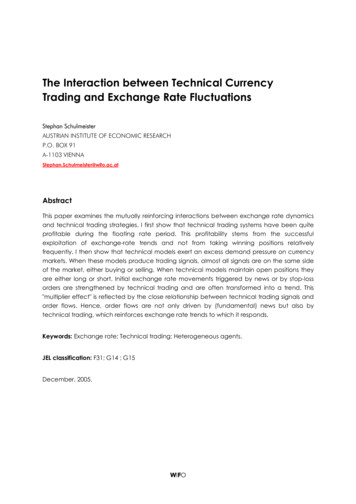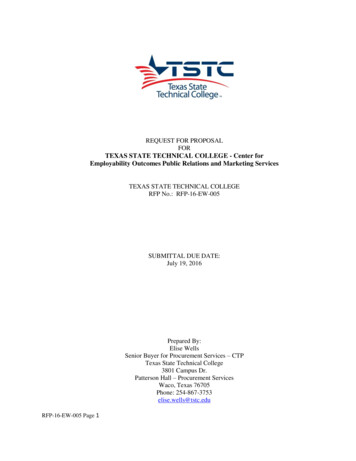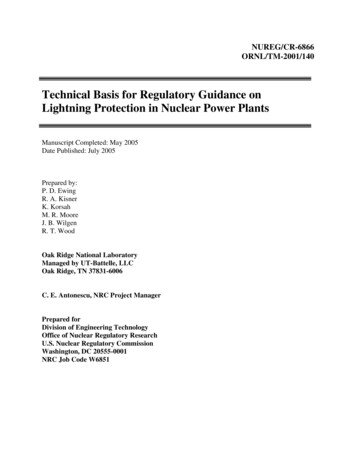
Transcription
NUREG/CR-6866ORNL/TM-2001/140Technical Basis for Regulatory Guidance onLightning Protection in Nuclear Power PlantsManuscript Completed: May 2005Date Published: July 2005Prepared by:P. D. EwingR. A. KisnerK. KorsahM. R. MooreJ. B. WilgenR. T. WoodOak Ridge National LaboratoryManaged by UT-Battelle, LLCOak Ridge, TN 37831-6006C. E. Antonescu, NRC Project ManagerPrepared forDivision of Engineering TechnologyOffice of Nuclear Regulatory ResearchU.S. Nuclear Regulatory CommissionWashington, DC 20555-0001NRC Job Code W6851
ABSTRACTOak Ridge National Laboratory (ORNL) has been engaged by the U.S. Nuclear Regulatory Commission(NRC) Office of Nuclear Regulatory Research (RES) to develop the technical basis for regulatoryguidance to address design and implementation practices for lightning protection systems in nuclearpower plants (NPPs). With the advent of digital and low-voltage analog systems in NPPs, lightningprotection is becoming increasingly important. These systems have the potential to be more vulnerablethan older, analog systems to the resulting power surges and electromagnetic interference (EMI) whenlightning hits facilities or power lines. This report documents the technical basis for guidance on theprotection of nuclear power structures and systems from direct lightning strikes and the resultingsecondary effects. Four Institute of Electrical and Electronics Engineers (IEEE) standards arerecommended for endorsement to address issues associated with the lightning protection of nuclear powerplants and their equipment and personnel: IEEE Std 665-1995 (R2001), IEEE Guide for GeneratingStation Grounding; IEEE Std 666-1991 (R1996), IEEE Design Guide for Electric Power Service Systemsfor Generating Stations, IEEE Std 1050-1996, IEEE Guide for Instrumentation and Control EquipmentGrounding in Generating Stations; and IEEE Std C62.23-1995 (R2001), IEEE Application Guide forSurge Protection of Electric Generating Plants.iii
CONTENTSABSTRACTLIST OF FIGURES AND TABLESEXECUTIVE SUMMARYACKNOWLEDGMENTSABBREVIATIONS AND ACRONYMSGLOSSARY1. INTRODUCTION1.1 Purpose1.2 Research Approach and Scope of Guidance1.3 Facts About Lightning1.4 History of NRC Lightning Protection Guidance2. LIGHTNING-RELATED OPERATING EVENTS2.1 Licensee Event Reports2.1.1 Summary of Lightning-Related Events from the Rourk Study (1980 – 1991)2.1.2 ORNL Study of Lightning-Related Events (1992 – 2003)2.2 U.S. NRC Reports2.2.1 Special Inspection 50-29/91-09 (Yankee Rowe – Loss of Offsite Power Event)2.2.2 Engineering Evaluation Report AEOD/E6052.2.3 NRC Information Notice 85-862.3 Industry Reports2.3.1 Nuclear Safety Analysis Center Report 412.3.2 Reports on World Wide Web3. KEY ISSUES OF LIGHTNING PROTECTION3.1 Review of ANSI/NFPA 780-20043.1.1 Zones of Protection3.1.2 Strike Termination Devices3.1.3 Down Conductors3.1.4 Ground Terminals3.1.5 Special Structures3.2 Review of UL 96A3.3 Guiding Principles of Lightning Protection4. REVIEW OF APPLICABLE STANDARDS4.1 Applicable Standards for Lightning Protection4.2 IEEE Std 665-1995 (R2001), IEEE Guide for Generating Station Grounding4.2.1 IEEE Std 665 Overview4.2.2 Grounding Principles (Section 5.1)4.2.3 Ground Grid Design (Section 5.2)4.2.4 Grounding of Main Generator Neutral (Section 5.3)4.2.5 Grounding of Buildings, Fences, and Structures (Section 5.4)4.2.6 Grounding of Generating Station Auxiliaries (Section 5.5)4.2.7 Lightning Protection for Generating Station Structures (Section 5.6)4.2.8 Grounding of Buried Structures (Section 5.7)4.2.9 Sizing of Grounding Conductors (Section 5.8)4.3 IEEE Std 666-1991 (R1996), IEEE Design Guide for Electrical Power Service Systemsfor Generating Stations4.4 IEEE Std 1050-1996, IEEE Guide for Instrumentation and Control EquipmentGrounding in Generating Stations4.5 IEEE Std C62.23-1995 (R2001), IEEE Application Guide for Surge Protection ofElectric Generating 212122222222232323252527272727282828282929292930
4.6 IEEE Std 80-2000, IEEE Guide for Safety in AC Substation Grounding4.7 IEEE Std 81-1983, IEEE Guide for Measuring Earth Resistivity, Ground Impedance, andEarth Surface Potentials of a Ground System4.8 IEEE Std 81.2-1991, IEEE Guide for Measurement of Impedance and SafetyCharacteristics of Large, Extended or Interconnected Grounding Systems4.9 IEEE Std 142-1991, IEEE Recommended Practice for Grounding of Industrial andCommercial Power Systems4.10 IEEE Std 367-1996, IEEE Recommended Practice for Determining the Electric PowerStation Ground Potential Rise and Induced Voltage from a Power Fault4.11 IEEE Std 487-2000, IEEE Recommended Practice for the Protection of Wire-LineCommunication Facilities Serving Electric Supply Locations4.12 IEEE Std 1100-1999, IEEE Recommended Practice for Powering and GroundingElectronic Equipment4.13 IEEE Std C37.101-1993, IEEE Guide for Generator Ground Protection4.14 IEEE Std C57.13.3-1983 (R1990), IEEE Guide for the Grounding of InstrumentTransformer Secondary Circuits and Cases4.15 IEEE Std C62.92.1-2000, IEEE Guide for the Application of Neutral Grounding inElectrical Utility Systems, Part I-Introduction4.16 IEEE Std C62.92.2-1989 (R2001), IEEE Guide for the Application of NeutralGrounding in Electrical Utility Systems, Part II-Grounding of SynchronousGenerator Systems4.17 IEEE Std C62.92.3-1993 (R2000), IEEE Guide for the Application of NeutralGrounding in Electrical Utility Systems, Part III-Generator Auxiliary Systems4.18 IEEE Std C62.41.1-2002, IEEE Guide on the Surge Environment in Low-Voltage(1000 V and Less) AC Power Circuits4.19 IEEE Std C62.41.2-2002, IEEE Recommended Practice on Characterization of Surgesin Low-Voltage (1000 V and Less) AC Power Circuits4.20 IEEE Std C62.45-2002, IEEE Recommended Practice on Surge Testing for EquipmentConnected to Low-Voltage (1000 V and Less) AC Power Circuits4.21 IEEE Std 998-1996, IEEE Guide for Direct Lightning Stroke Shielding of Substations5. ASSESSMENT OF LIGHTNING PROTECTION REQUIREMENTS5.1 Overall Grounding Plan5.1.1 Grounding Overview5.1.2 Grid Design5.1.3 Grounding Systems5.2 Lightning Protection System5.2.1 LPS Overview5.2.2 Striking Distance5.2.3 Strike Termination Devices (Air Terminals)5.2.4 Down Conductors5.2.5 Lightning Earthing System5.3 Conductors Egressing the LPS5.3.1 Service Entrance (Power Lines)5.3.2 Wire-Line Communications5.3.3 External Systems and Piping5.4 Cable Routing inside the Lightning Protection System5.5 Protection of Medium-Voltage Equipment5.6 Surge Protection Devices5.7 Surge Testing of Equipment5.8 Maintenance and Testing of LPSs5.9 Alternative Lightning Protection 53738383839393940404040414141424242
6. RECOMMENDATIONS7. REFERENCES4547ix
LIST OF FIGURES AND TABLESFigures1 Components of research approach.2 Elements of the power plant system.3 Facts about lightning .4 Lightning-related events for two 12-year periods (1980-1991, 1992-2003) .5 Lightning-related events by year .6 Yankee Nuclear Power Station June 15, 1991 lightning event sequence.7 Issues for lightning protection in generating stations.8 Diagram showing the interdependencies of the standards applicable to lightning protection atnuclear power plants.9 Overview of lightning protection standards for generating stations.10 Three types of grounding covered by IEEE Std 665 .263738Tables1 Comparison of lightning-related events .2 Lightning-related events by year .3 Units in AEOD/E605 review.4 Key lightning protection issues .5 The 20 standards judged most applicable to lightning protection for nuclear power plants .6 Lightning protection checklist and the standards that address checklist issues.8914242536xi122891024
EXECUTIVE SUMMARYOak Ridge National Laboratory (ORNL) has been engaged by the U.S. Nuclear Regulatory Commission(NRC) Office of Nuclear Regulatory Research (RES) to develop the technical basis for regulatoryguidance to address design and implementation practices for lightning protection systems in nuclearpower plants (NPPs). With the advent of digital and low-voltage analog systems in NPPs, lightningprotection is becoming increasingly important. These systems have the potential to be more vulnerablethan older, analog systems to the resulting power surges and electromagnetic interference (EMI) whenlightning hits facilities or power lines. This report documents the technical basis for guidance on theprotection of nuclear power structures and systems from direct lightning strikes and the resultingsecondary effects.The scope of the technical basis for guidance includes protection of (1) the power plant and relevantancillary facilities, with the boundary beginning at the service entrance of buildings; (2) the plantswitchyard, (3) the electrical distribution system, safety-related instrumentation and control (I&C)systems, communications, and personnel within the power plant; and (4) other important equipment inremote ancillary facilities that could impact safety. The scope includes signal lines, communication lines,and power lines. The scope also includes the testing and maintenance of the lightning protection systems.The scope does not cover the testing and design practices specifically intended to protect safety-relatedI&C systems against the secondary effects of lightning discharges, i.e., low-level power surges and EMI.These practices are covered in Regulatory Guide (RG) 1.180, Guidelines for Evaluating Electromagneticand Radio-Frequency Interference in Safety-Related Instrumentation and Control Systems.This report recommends that four primary standards be endorsed in their entirety for the lightningprotection of NPPs and their equipment and personnel: IEEE Std 665-1995 (R2001): This report recommends that IEEE Std 665 be endorsed for guidance onlightning protection for NPPs. This standard draws heavily from NFPA 780, which is widely acceptedfor lightning protection of most types of structures but which specifically excludes power generationplants. One exception is taken to this standard due to a misquote. IEEE Std 666-1991 (R1996): This report recommends that IEEE Std 666 be endorsed for its coverageof grounding and surge protection for medium-voltage equipment in NPPs. IEEE Std 1050-1996: In addition to IEEE Std 665 and IEEE Std 666, which focuses on the directeffects of lightning strokes, this report recommends the endorsement of IEEE Std 1050, which coversthe specific components necessary to prevent damage to I&C equipment from the secondary effectsof lightning. IEEE Std C62.23-1995 (R2001): This report recommends the endorsement of IEEE Std C62.23 asgeneral guidance on surge protection. This standard consolidates many electric utility power industrypractices, accepted theories, existing standards/guides, definitions, and technical references as theyspecifically pertain to surge protection of electric power generating plants.This report further recommends that the applicable portions of IEEE Std 80, IEEE Std 81, IEEE Std 81.2,IEEE Std 142, IEEE Std 367, IEEE 487, IEEE Std 1100, IEEE Std C37.101, IEEE Std C57.13.3, IEEEStd C62.92.1, IEEE Std C62.92.2, IEEE Std C62.92.3, IEEE Std C62.41.1, IEEE Std C62.41.2, and IEEEStd C62.45 be endorsed (with qualifications) by the endorsement of the four primary standards. Thesestandards are referenced and provide necessary details not recorded in the primary standards.xiii
xiv
ACKNOWLEDGMENTSThe authors wish to thank Christina Antonescu, JCN W6851 Project Manager, and Bill Kemper, SectionChief, of the U.S. NRC Office of Nuclear Regulatory Research (RES) for her help in initiating, planning,and implementing this research effort.xv
ABBREVIATIONS AND PNRCNSACOCBORNLRCICRESRTDSPDSPDSSSTULUPSU.S.Air circuit breakerAmerican National Standards Institutebasic impulse levelcircuit breakerDepartment of Energyemergency diesel generatorelectromagnetic interferenceelectromagnetic pulseemergency notification systememergency offsite facilityengineering safety featureground potential risehigh pressure coolant injectioninstrumentation and controlsInternational Electrotechnical CommissionInstitute of Electrical and Electronics Engineersinformation technologylightning electromagnetic pulselicensee event reportloss of power telephoneslightning protection systemlightning protection zonelightning warning systemmain coolant pumpmultipoint discharge systemnuclear alert systemnon-essential uninterruptible power supplyNational Fire Protection Associationnuclear power plantU.S. Nuclear Regulatory CommissionNuclear Safety Analysis Centeroil circuit breakerOak Ridge National Laboratoryreactor core isolation coolingOffice of Nuclear Regulatory Researchresistance temperature detectorsurge protection devicesafety parameter display systemservice station transformerUnited Laboratoriesuninterruptible power supplyUnited Statesxvii
re, unit of currentalternating currentdirect currentfeet, unit of lengthsquare inch, unit of areakilo square meter–103 m2, unit of areakilovolt–103 V, unit of voltagemeter, unit of lengthsquare meter, unit of areamegavolt-ampere–106 VA, unit of apparent powermicrosecond–10-3 sec, unit of timeminute, unit of timeohm, unit of resistanceohm-centimeter, unit of area resistivitysecond, unit of timevolt, unit of voltagexix
1. INTRODUCTION1.1 PurposeOak Ridge National Laboratory (ORNL) has been engaged by the U.S. Nuclear Regulatory Commission(NRC) Office of Nuclear Regulatory Research (RES) to develop the technical basis for regulatoryguidance to address design and implementation practices for lightning protection systems (LPSs) innuclear power plants (NPPs). With the advent of digital and low-voltage analog systems in NPPs,lightning protection is becoming increasingly important. These systems have the potential to be morevulnerable than older, analog systems to the resulting power surges and electromagnetic interference(EMI) when lightning hits facilities or power lines. The purpose of this report is to document thetechnical basis for guidance on the protection of nuclear power structures and systems from directlightning strikes and the resulting secondary effects.1.2 Research Approach and Scope of GuidanceThe three components thought to be needed to establish a detailed technical basis for regulatory guidanceon lightning protection are shown in Fig. 1. Because of time constraints, the approach taken during thisresearch includes only two of the components. The first step of the approach is to ascertain the relevanceof lightning protection guidance by assessing operating experiences associated with lightning strikes. Thesources of these experiences include licensee event reports (LERs), other NRC reports, and industryreports. The second step is to review and select industry standards suitable to provide adequate lightningprotection. The third logical step would be to do a detailed system analysis that includes failuremechanisms within plants and their subsequent effects. These failure mechanisms might include theeffects of excessive voltage and current, coupling mechanisms (e.g., inductive, capacitive, and conductivecoupling), and the breakdown mechanisms for plant equipment, surge protection devices, and wireinsulation. The first two steps are adequate for establishing the technical basis at present and the thirdstep is recommended if additional rationale is ngExperiences(LERs, OtherNRC Reports,Etc.)Failure Mechanisms(Failure Modes andEffects Analysis)Figure 1.Components of research approach.1
The scope of the technical basis for guidance includes protection of (1) the power plant and relevantancillary facilities, with the boundary beginning at the service entrance of buildings; (2) the plantswitchyard, (3) the electrical distribution system, safety-related instrumentation and control (I&C)systems, communications, and personnel within the power plant; and (4) other important equipment inremote ancillary facilities that could impact safety. Fig. 2 illustrates how the elements of the power plantsystem tie together. The scope includes signal lines, communication lines, and power lines. The scopealso includes the testing and maintenance of LPSs. The scope does not cover the testing and designpractices specifically intended to protect safety-related I&C systems against the secondary effects oflightning discharges, i.e., low-level power surges and EMI. These practices are covered in RegulatoryGuide (RG) 1.180, Guidelines for Evaluating Electromagnetic and Radio-Frequency Interference inSafety-Related Instrumentation and Control Systems [1]. Any future guidance on lightning protectionfounded on the technical basis developed in this report is expected to complement RG 1.180 by helping toensure that the electromagnetic phenomena induced within NPPs as a result of lightning activity do notexceed the expected RG 1.180 levels.Systems Located within SitePowerSafetyRelated I&CSystemsDigital &AnalogSignalsGround SystemFigure 2.Elements of the power plant system.1.3 Facts About LightningWeather experts report that lightning strikes the earth 100 times each second around the world and that16 million thunderstorms occur worldwide each year [2]. The regions most prone to this violent weatherare those where very moist and unstable air masses move through year-round (e.g., regions in closeproximity to the Gulf of Mexico and the Atlantic Ocean) [3]. Some additional facts about lightning areshown in Fig. 3.Lightning packs between 35,000 to 40,000 A of current, can generate temperatures as high as 50,000ºC, travels as far as 40 miles, can, and does, strike the same place twice, kills nearly 100 people each year in the United States and injures hundredsof others, and causes billions of dollars in property damage each year, many timesresulting in fire and total property loss.Source: Lightning Protection Institute, “Lightning and Lightning ProtectionSystems,” at http://www.lightning.org/protect.htm, 1999.Figure 3.Facts about lightning.2
1.4 History of NRC Lightning Protection GuidanceDuring the research for this report, it was found that a draft regulatory guide had been written in 1979entitled Lightning Protection for Nuclear Power Plants. The draft guide described criteria acceptable tothe NRC staff for the design, application, and testing of LPSs to ensure that electrical transients resultingfrom lightning phenomena did not render systems important to safety inoperable or cause spuriousoperation of such systems. Specific practices on the use of lightning rods (air terminals) from NationalFire Protection Association (NFPA) 78-1968, Lightning Protection Code, were endorsed. Note that thisstandard has been updated a number of times since 1968 and the latest version is NFPA 780-2004,Standard for the Installation of Lightning Protection Systems [4]. The draft guide also endorsed practiceson the use of surge arresters found in two American National Standards Institute (ANSI) standards.Issues such as common mode failures, surge protection of redundant systems, and surge protection ofsolid-state logic systems were mentioned but not discussed in great detail. The draft regulatory guide wasnever finalized and was subsequently terminated in 1981.Petition for Rulemaking (PRM) 50-56 [5] was originated in 1991 by Richard Grill, a former NRC staffer,petitioning the NRC to again address concerns related to lightning, as well as other sources such aselectromagnetic pulses (EMP), EMI, geomagnetic currents, and ferromagnetic effects. The PRM 50-56petition specifically requested that lightning (and the other electrical transients) be added to the list ofphenomena that NPPs must be designed to safely withstand, and that licensees be required to “considerthe effect of electrical transients on the operability and reliability of nuclear safety related systems andpotential accident scenarios to assure that such transients can not compromise the safety of the facilityor the health and safety of the public.” The petition also requested that NRC regulations be amended torequire that this “unreviewed safety question be scoped, reviewed, and resolved for all nuclear powerplants on a generic basis ” The main motivation, and reason for concern, for Mr. Grill was thatpotential effects of electrical transients on the integrity of safety related systems had not been rigorouslyanalyzed, nor had implications for safety been factored into conservative preventative designs, as hadbeen done previously when considering other natural (and man-made) phenomena, such as earthquakes,floods, tornados, tsunamis, and aircraft crashes.The NRC staff issued a report authored by Chris Rourk, Report on the Sources and Effects of ElectricalTransients on the Electrical Systems of Commercial Nuclear Power Plants [6], in 1992 in response toPRM 50-56. The Rourk report was structured accordingly, with EMP, geomagnetic currents,ferromagnetic effects, switching surges, and lightning being addressed in individual chapters. EMI wasnot addressed in this report because it was being studied under a separate program that eventually led tothe issuance of RG 1.180. Lightning related LERs were reviewed to address concerns that could not beaddressed by a review of information in the technical literature. The purpose was to examine whether, onthe basis of operating experience, NPPs are adequately protected from the transients associated withlightning strikes. Based on the review of the lightning related LERs, the report concluded that “it does notappear that the effects from electrical transients which have occurred could compromise the safeshutdown of licensed nuclear power plants.” It further stated that “regulation of lightning protectiondoes not appear to be justified on the basis of safety significance. However, in light of the increasingreliance on digital controls, it seems prudent to consider changes to regulatory requirements for futureplants.” It also stated that “the structural and power line protection practices currently used by licenseesappear to adequately protect licensed facilities from the effects of direct strikes based upon the operatingexperiences reviewed in this report. Therefore, existing standards could be used as the technical basisfor consideration of any new regulation for structural and power line protection.”This is where the status of regulatory guidance on lightning protection stood until the initiation of theORNL research effort. As stated earlier, ORNL’s approach is to ascertain the relevance of lightning3
protection guidance by assessing the operating experiences in NPPs associated with lightning strikes. Thesources include LERs, other NRC reports, and industry reports. A review of lightning-related operatingevents is discussed in Section 2.4
2. LIGHTNING-RELATED OPERATING EVENTS2.1 Licensee Event ReportsLightning-related events from LERs were reviewed for the period 1980 to 2003. LERs for the period1980 to 1991 had been reviewed by Rourk [5] to identify events involving equipment misoperation anddamage caused by lightning strikes. The results of this review are reported in Ref. [6]. ORNL staff builtupon this earlier work by reviewing lightning-related events from 1992 to 2003 and comparing the resultswith the Rourk study. In order for the ORNL review and analysis to be a logical extension of the studyby Rourk, similar analysis methods to those used in the Rourk study were applied. For example, theORNL study uses the same categorization of lightning-related events used by Rourk.2.1.1 Summary of Lightning-Related Events from the Rourk Study (1980 – 1991)The objective of the Rourk review was to determine “whether any trends were developing that indicatedpotential problems due to lightning.” Significant results of the review are identified below: A total of 174 events were reported.Six events involved a total loss of offsite power.42 events involved the loss of one or more offsite power sources.Only 1 of the 42 events cited involved any equipment damage.The other 41 events included some adverse equipment effects that appeared to result from lowvoltage at the plant (e.g., the tripping of equipment protective relays), but did not involve anyequipment damage or failure.Six events involved loss of fire protection equipment from lightning, but no fire actuallyoccurred.Four events involved a fire at the plant caused by lightning. (Note: It is likely that additional fireshave occurred at plants that were not reported on LERs, because to be reportable an event mustinvolve actuation or unavailability of safety-related equipment or systems.)Of the 174 events, only 58 involved reactor trips.20 events involved actuation of the control rod drive DC power supply over-voltage protection.When this happens, the control rod gripper units are de-energized, causing the control rods to fallinto the reactor core. The reactor then trips because of a high negative flux rate.18 events involved damage to meteorological equipment mounted on towers. Such events do notthreaten the ability of a plant to safely shut down. However, they do establish that one indicationof a local lightning strike is failure of equipment on a meteorological tower.Conclusions from the Rourk study included the following: Most events that resulted in component damage appeared to have been caused by a local strike,rather than a transmission line strike.Although it is possible that a lightning strike may result in a fire simultaneously with the loss offire protection, such a scenario did not occur in the 12-year period reviewed. Taken into accountthe number of operating reactors within the period, this constituted 967 years of plant operation.The most significant impact on plant operations that may be caused by lightning is from theeffects of local strikes.High-frequency voltage transients created on the transmission system by lightning do not causesignificant equipment misoperation or damage.5
2.1.2 ORNL Study of Lightning-Related Events (1992 – 2003)Lightning-related events from 1992 – 2003 were analyzed and grouped into categories. Note that thisperiod covers the next 12 years after the 12-year period reviewed by Rourk (1980 – 1991). In order tocompare the two reviews, methods of analysis similar to those used by Rourk were applied and thecategorization of events follows the same methods used by Rourk. To have reasonable assurance thatsimilar search methods were used, the keywords used to search for lightning-related events for the 1992 –2003 period were also used to retrieve lightning-related events from 1980 – 1991. A total of 172 eventswere retrieved. The Rourk study reported a total of 174 lightning-related events for the same period. Thepercentage difference ( 2%) is small, and provides additional assurance of the validity of anycomparisons made with regard to the two review periods. The search for lightning-related occurrencesfrom 1992-2003 uncovered a total of 66 events. This is a significant reduction from the 174 eventsreported in the Rourk study.The following is a category-by-category comparison of lightning-related LER events within the twoperiods of study:Loss of Offsite Power, Without Equipment Damage:A loss of offsite power occurs when any transmission line connecting the plant to the power system isdisconnected by circuit breakers. A plant typically has more than one offsite power source. Plants arealso required to have on-site backup sources, such as diesel generators, to provide sufficient power tosafely shut down the plant in case of a total loss of offsite power.The ORNL review found a total of 21 events that involved a loss of one or more offsite power sources,but which did not result in equipment damage. This is in contrast with 41 events reported for the samecategory for the period 1980-1991 in the Rourk study.Loss of Offsite Power, Accompanied by Equipment Damage:A lightning strike on a transmission line creates a surge on the line with a current magnitude that isdetermined by the charge characteristics of the lightning and the location of the strike. By contrast, theeffect of a local strike will be largely dependent on the magnitude and distribution of ground potential riseand capacitive and inductive coupling of plant equipment to the lightning channel.Examination of the LER events in the 1992 – 2003 period did not uncover any loss of offsite powerevents that subsequently resulted in plant equipment damage. The Rourk study found one event in thiscategory. Thus, there is
4.9 IEEE Std 142-1991, IEEE Recommended Practice for Grounding of Industrial and Commercial Power Systems 31 4.10 IEEE Std 367-1996, IEEE Recommended Practice for Determining the Electric Power Station Ground Potential Rise and Induced Voltage from a Power Fault 31 4.11 IEEE Std 487-2000, IEEE
